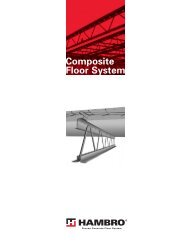You also want an ePaper? Increase the reach of your titles
YUMPU automatically turns print PDFs into web optimized ePapers that Google loves.
DESIGN PRINCIPLES AND CALCULATIONS - LATERAL LOAD DISTRIBUTION<br />
LATERAL LOAD DISTRIBUTION<br />
FOR LINE LOADS<br />
Line loads are often encountered in construction, i.e. a<br />
concrete block wall or even a load bearing concrete block wall.<br />
It is always desirable to have a floor system that is stiff enough<br />
to allow these line loads to be distributed to adjacent joists<br />
rather than it be carried by the joist that happens to be directly<br />
under it.<br />
The <strong>Hambro</strong> Composite Floor System provides the designer<br />
with this desirable feature.<br />
This was conclusively proven by randomly selecting a sample<br />
of five similar adjacent joists in a bay in an apartment structure<br />
and line loading the center one.<br />
The joists were 12” deep, had a clear span of 21’- 3” and<br />
a 3” thick slab. The loads were applied using brick pallets.<br />
At every load stage, steel strains as well as deflections<br />
were measured.<br />
The distribution of load to each of the five joists can be<br />
determined by comparing deflections or stresses at similar<br />
locations in the five joists under investigation.<br />
Tests have demonstrated that for a line load applied to a<br />
typical joist in a bay, the actual distribution of load to that joist<br />
is approximately 40% of the applied load. The distribution of<br />
load to the adjacent joist on either side is approximately 21% of<br />
the applied load and to the next adjacent joist approximately<br />
9% of the applied load.<br />
15



